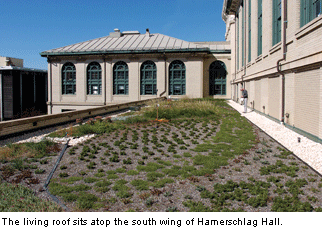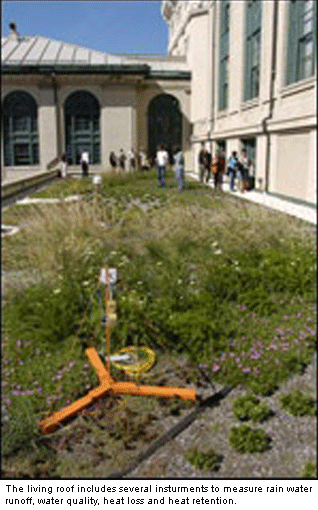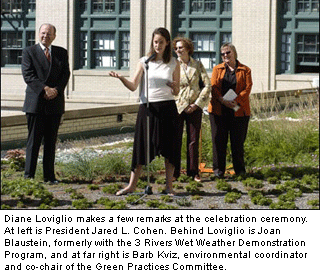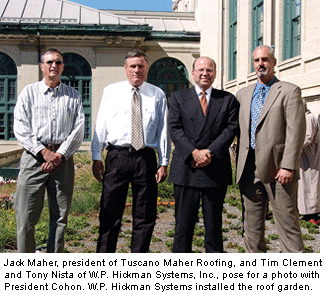Four years ago, three students in Carnegie Mellon’s Sustainable Earth Club looked up and had an idea: replace the deteriorating south wing roof of Hamerschlag Hall with an environmentally friendly green, or living, roof.

While little was known to quantify the advantages of a green roof over a conventional one, the students knew that rooftop gardens conserve energy and preserve the environment.
That idea for a small undergraduate research project—initially conceived by Diane Loviglio (BHA’05), Aria Thomases (CFA’02) and Landis Kauffman (CFA’02)—sits on top of Hamerschlag Hall today.
“This project typifies the fantastic commitment, creativity and collaboration of our students,” said President Jared L. Cohon at a September ceremony celebrating the green roof. “Preserving the environment is a high priority for Carnegie Mellon in education, research and practices, and this project touches on all three of those dimensions.”
After Thomases and Kaufmann graduated in 2002, Loviglio worked with faculty advisor Bob Bingham, Carnegie Mellon’s Green Practices Committee and the university’s Facilities Management Services (FMS) to keep the project moving forward.

The big boost came late in 2003, when Governor Edward Rendell awarded a $96,750 grant to Carnegie Mellon from the Pennsylvania Energy Harvest program, which supports advanced and renewable energy technologies. A few months later, the project received $25,000 from the 3 Rivers Wet Weather Demonstration Program, an effort to improve storm water management and water quality in Allegheny County.
Art, architecture and engineering students in Bingham’s “Advanced Sculpture” studio class designed the green roof last spring. The design was implemented by W.P. Hickman Systems, Inc., which has installed a number of green roofs across the country, from Seattle to Maryland.
From the bottom up, the living roof consists of a conventional flat roof (concrete, two layers of thermal insulation, two layers of 160-mil torch-applied roof membrane and one layer of 180-mil premium torch-applied membrane) covered by the soil, plants, and water control systems of the living roof (filter fabric, a two-inch layer of gravel, another layer of filter fabric, four inches of specially designed soil, and metal flashing around the perimeter). The top of the green roof includes grasses, perennials, logs and a small rock-bed pond.

“This was an elaborate and very unusual design,” said Tim Clement of W.P. Hickman. “It was developed to incorporate a comprehensive energy and water monitoring system, which required some special design features. Once fully developed, no gravel will show. The plants will grow out to cover the entire roof.”
Bingham said W.P. Hickman worked very well with the students on the project. “We went ‘design-build,’ which is very important,” Bingham said.
The living roof provides extra insulation that reduces the amount of heating and cooling needed for the offices, classrooms and labs below. It reduces storm water runoff, which improves water quality, and reduces heat retention in the summer caused by traditional roofing materials.

The living roof is also a living lab. Several monitors and instruments have been installed to measure rain water runoff, water quality, heat loss and heat retention. Control monitors have been installed on the traditional Porter Hall roof to compare and contrast the data. Architecture grad student Megan Snyder and civil and environmental engineering grad student David Carothers were instrumental in developing and integrating the energy and water monitoring systems.
“This project serves as a model and test case for our region,” said Civil and Environmental Engineering Professor Dave Dzombak, co-chair of the Green Practices Committee. Dzombak and Civil and Environmental Engineering Professor Cliff Davidson worked with the student team to devise and install the measuring devices.
“This isn’t just a green roof, it’s a research project,” said Barb Kviz, FMS environmental coordinator and co-chair of Carnegie Mellon’s Green Practices Committee.
So, what started as a research project continues to be a research project.
“This is just the beginning,” Loviglio said.
Related Links:
Green Practices Committee
Civil and Environmental Engineering Department
David Dzombak
Bob Bingham



